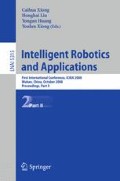Abstract
Unmanned Air Vehicle is a kind of flying intelligence robot with real-time reaction ability. Using the multi-agent idea in the exploitation of the unmanned air vehicle team Intelligence control system (UAVTICS) will enhance its intelligence degree greatly. The article introduces the design idea of Cruise Missile Weapon Control System, build the multi-agent frame of UAVTICS, and design the architecture of the fly-control agent and single unmanned air vehicle agent with “human-machine integration approach”. And the model of unmanned air vehicle team agent is also described.
Access this chapter
Tax calculation will be finalised at checkout
Purchases are for personal use only
Preview
Unable to display preview. Download preview PDF.
References
Besselman, J., logsdon, M., Whisnant, B.E.: The tactical tomahawk weapons control system.Interface design project, http://www.sys.virginia.edu/hci/papers/capstonepaper5.doc
Michael, W.A.: Introduction to MultiAgent Systems. Publishing House of Electronics Industry, Beijing (2003)
Zhang, W.M., Li, Y.: Intelligent and Cooperative Information Technology. Publishing House of Electronics Industry, Beijing (2002)
Zhang, O.Y., Tong, M.A.: Agent-Oriented Design of Cruise Missile Weapon Control System Architecture. Fire Control and Command Control 8, 33–36 (2007)
Huang, X.Y., Liu, W.H., Ma, X.X.: Mechanism of Human-Machine Cooperation Based on Agent and the Role of Human Being. Journal of Chongqing University Natural Science Edition 25, 32–35 (2002)
Robert, A.W.: Tactical Tomahawk Weapon Control System User Interface Analysis and Design. The School of Engineering and Applied Science University of Virginia (2001)
Zhu, N.Z., Zhu, D.C.: Command Automation System Engineering. Publishing House of Electronics Industry, Beijing (2001)
Liu, J.X., Tong, M.A.: Study on Models of Multi-Agent System Based Group Aircraft Cooperative Air Combat Command Control System. Electronics Optics & Control 31, 49–53 (2001)
Liu, J.X., Tong, M.A.: Cooperative Attack Action of Multi-UAV Team. Flight Dynamics 21, 16–19 (2003)
Tan, Y.Y., Zhao, R.C.: Intelligent Agent-Based Design and Implementation of Autonomous Task Manager for Small UAVS. Journal of Northwestern Polytechnical University 12, 757–759 (2006)
Author information
Authors and Affiliations
Editor information
Editors and Affiliations
Rights and permissions
Copyright information
© 2008 Springer-Verlag Berlin Heidelberg
About this paper
Cite this paper
Guo, N., Lv, J., Yu, J. (2008). Research on the Unmanned Air Vehicle Team Intelligence Control System Based on Multi-agent. In: Xiong, C., Liu, H., Huang, Y., Xiong, Y. (eds) Intelligent Robotics and Applications. ICIRA 2008. Lecture Notes in Computer Science(), vol 5315. Springer, Berlin, Heidelberg. https://doi.org/10.1007/978-3-540-88518-4_9
Download citation
DOI: https://doi.org/10.1007/978-3-540-88518-4_9
Publisher Name: Springer, Berlin, Heidelberg
Print ISBN: 978-3-540-88516-0
Online ISBN: 978-3-540-88518-4
eBook Packages: Computer ScienceComputer Science (R0)

